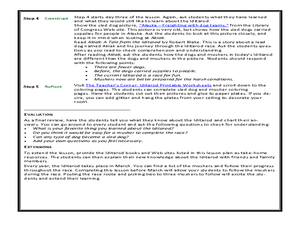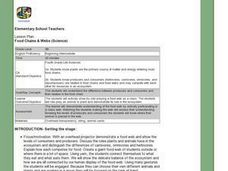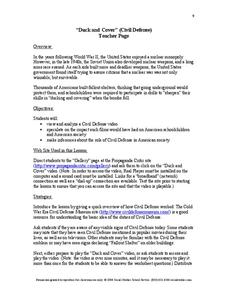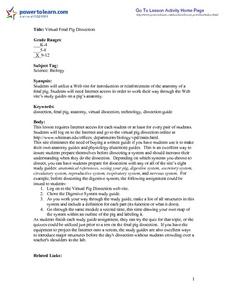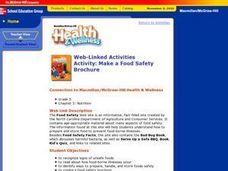Curated OER
My Personal Pyramid
Students complete a WebQuest that explores three different food pyramids. In small groups, they explore the websites, complete a Venn diagram, and design a mini-poster of a food pyramid that meets nutritional standards and includes their...
Curated OER
The Iditarod: The Last Great Race
Students investigate the Iditarod. In this last great race lesson, students explore and research the Iditarod race which takes place in Alaska. Students explore a variety of websites and images to gather background information. A...
Curated OER
Nested Similar Triangles
Nested triangles have been created so that they share a common vertex and vertex angle. Learners drag the endpoints of the side that is opposite the common angle to discover the conditions that make the nested triangles similar. When...
Curated OER
Pythagorean Relationships
Oh that Pythagorean Theorem is so useful. Learners engage in a 45 minute learning activity that requires them to solve for missing angles and sides of a right triangle. They'll use the Pythagorean Theorem to find the rations of sides and...
Curated OER
Human VS Animal Skeletons
Students research and compare human and animal skeletons. They identify human skeletons basic functions and parts.
Curated OER
Food Chains & Webs
Fourth graders examine roles of animals in food chain, explore roles of humans, plants, and animals in ecosystem, create their own food webs, and role play producers, consumers, and decomposers.
Curated OER
Ramona Quimby, Age 8
Third graders read Beverly Cleary's book "Ramona Quimby, Age 8" and then complete a series of extension activities. Students explore cause and effect, sequencing, related websites, grammar lessons and comparison skills.
Curated OER
What is Diabetes?
Students examine basic information about diabetes and related vocabulary words. They explore various health websites, complete a worksheet, discuss the worksheet answers and discuss diabetes myths vs. facts.
Alabama Learning Exchange
Creating a Reflection
Investigate geometric reflections in this geometry lesson. Create geometric reflections that show the reflection across the x and y axis of a coordinate graph. Learners watch a teacher demonstration before proceeding on their own. They...
Curated OER
The Truth About Human Rights
Students explore the concept of human rights. In this human rights lesson, students watch 2 videos regarding human rights violations around the world since 2001. Students explore several websites that feature human rights violations....
Curated OER
Language Arts Exploration
While an interesting lesson idea involving the exploration of a story about an Asian American boy named Imduk, a teacher would need to have assess to the Scott Foresman reading program to make this work. If not, a teacher could use...
Curated OER
Referencing the Classical Past
Students discuss the sculptural group of Three Goddessesby Joseph Nollekens in a study of the classical past. In this Classical history lesson, students describe the three figures in the painting and read an excerpt for the story the art...
Curated OER
Environment: John Muir Day
Students observe John Muir Day by visiting Websites containing fact sheets, excepted writings, as well as songs, pictures, and educational sources. They use April 21 as a day to reflect on Muir's accomplishment and environmental legacy....
Teach Engineering
What Does Light See?
The second installment of a seven-part series focuses on the refraction of light and how it affects the colors we see. Learners consider how this concept connects to biosensors for cancer detection.
Curated OER
Agriculture Awareness Through Poetry
Whether you are viewing a landscape painting of a farm, examining a still-life portrait of a bowl of fruit, or reading a descriptive poem about cultivating food, you can't deny that agriculture plays a major role in visual and language...
Social Studies School Service
“Duck and Cover” (Civil Defense)
Bert the Turtle models for viewers the 1950s Civil Defense Duck and Cover strategy that was supposed to protect citizens from a nuclear blast. After viewing the video, watchers are asked to consider the motivations of the producers of...
Curated OER
Virtual Fetal Pig Dissection
Students use the internet to introduce themselves to the anatomy of a fetal pig. In pairs or individually, they work their way through a virtual dissection of a fetal pig while completing questions on a study guide. They also develop...
Curated OER
Treatment Works!
Learners consider the goals of a treatment plan for persons who have had the way they think, feel, or behave changed because of mental illness. PET images are utilized to support the evidence of changes in the activity and functioning of...
Curated OER
Constellation Companions
Students research the star composition for a constellation after a brainstorming session suggesting why humans have organized the night sky into constellation patterns. They use the research to create their own constellation and myth...
Curated OER
Properties of Dust
Students examine the dust in their classroom and relate it to the dust in space. In this investigative lesson students collect dust and graph their findings.
Curated OER
Energy Is Everywhere
Young scholars determine the difference between renewable and non-renewable resources and identify the different forms of energy. They discuss life without energy and where energy comes from before reading an article about the different...
Curated OER
Stellar Fingerprints: the Spectra of Stars
Students explain how an element can be identified using emission spectra. They relate the emission spectrum of hydrogen to its absorption spectrum and identify hydrogen absorption lines in the spectrum of stars.
Curated OER
Animal Homes
Children visit one particular website to explore animals that live in different habitats. After visiting the website, they choose to research one habitat and the animals that live there. They create a poster about their animal and where...
Curated OER
Make a Food Safety Brochure
Learners create brochures that inform their families how to prepare and store food to prevent food-borne illnesses. They research food safety facts and proper food-handling techniques on the internet.

